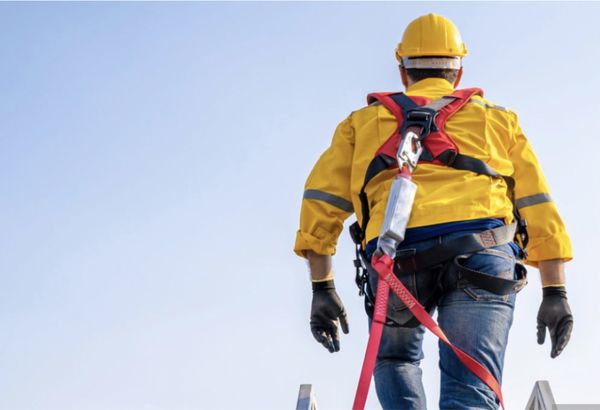7 November 2024
Arc flash PPE: Everything you need to know
Arc flash PPE (personal protective equipment) is absolutely essential for electrical workers. Without this specialist protective workwear, electricians, electrical engineers and other workers who regularly come into contact with electrical equipment would be vulnerable to arc flash incidents, which can be highly dangerous and potentially fatal.
But what is an arc flash incident, and how does arc flash PPE protect against common arc flash injuries? Let’s discuss everything you need to know about arc flash protective clothing, including who it’s for, when it’s required, and how to choose high-quality arc flash workwear that keeps your employees safe.
what are arc flash incidents?
An arc flash is caused by an accidental short circuit in electrical equipment. When something obstructs the normal flow of electricity, this creates an arc in the air between two electrical phases or between a phase and the ground.
On a more detailed level, the arc flash is an explosion of oxygen in the air around the phase(s), causing extremely high temperatures of up to 19,000°C – hotter than the surface of the sun. In addition to this catastrophic heat, an arc flash explosion has the potential to violently blast shards of shrapnel and molten metal within the vicinity of the incident, and this will be accompanied by a blinding flash of light and a very loud bang.

what are the most common welding injuries
As you can imagine, serious burns are common arc flash injury due to the extreme heat of this electrical explosion. Victims can also be hit by flying shrapnel, leading to a wide range of impact injuries and lacerations – which have the potential to become infected too.
Whilst serious burns are usually the most common arc flash injury, the blinding light and large bang accompanying the incident can cause additional injuries. The intensity of the sound blast – which can reach up to 140 decibels – can rupture eardrums and potentially lead to permanent hearing problems or deafness. Similarly, the brightness of the arc flash can cause temporary blindness, or even permanent blindness and eye damage in more severe cases.
what is arc flash PPE?
Arc flash PPE or arc flash clothing is a type of specialist protective workwear designed to reduce the risk of arc flash injuries for workers who could potentially be exposed to arc flash incidents – such as electricians. To be classed as arc flash PPE, this clothing and equipment must be ‘arc-rated’, meaning that it has passed a range of tests ensuring it meets required standards for wearer protection. Arc flash PPE is designed to absorb the incident energy of an arc flash – protecting the wearer against burns – and also provide ear and eye protection in the form of face shields, goggles and earmuffs.
However, arc flash PPE is generally the last line of defence against arc flash injuries, as this equipment is primarily designed to reduce the amount of second-degree burns to a survivable level for the wearer. Whilst arc flash PPE is absolutely essential, the best protection for your workers is the prevention of these incidents in the first place. So, if a risk assessment has deemed a workplace is at risk of arc flash incidents, measures should be introduced to minimise the risk of workers being exposed to arc flashes and arc flash injuries, such as:
- Using arc-resistant equipment
- Reducing the available fault current
- Powering down electrical equipment where possible
- Staying at a safe distance
- Providing extensive arc flash safety training to employees
- Providing first aid training for use in emergencies
- Conducting regular workplace risk assessments and hazard analyses
All of the above measures should be in place alongside the provision of arc flash PPE, which is an employer’s legal obligation if risk assessments have deemed the use of PPE necessary. PPE shouldn’t be used as the only defence; it works best as part of an overall hazard reduction strategy, in which steps are taken to identify hazards, mitigate them, keep employees at a safe distance, and train everyone on-site.
types of arc flash PPE
Since there’s a range of common arc flash injuries that workers could be vulnerable to, arc flash PPE needs to be fully comprehensive. As a result, workers will typically need multiple types of arc flash clothing and PPE, including:
- Arc flash coveralls to protect as much of the body from second-degree burns as possible
- Arc flash jackets or shirts with long sleeves that ensure no skin is exposed
- Face shields to protect the face from burns or damage to the eyes
- Arc flash hoods to protect the head and face
- Goggles for eye protection
- Earmuffs to protect the eardrums
- Arc flash trousers to protect the lower body from burns
There are also other pieces of clothing that must be considered when working in environments at risk of arc flash incidents. For example, many workers forget about their underwear, assuming that it’s irrelevant since it’s totally covered, but the extreme heat of an arc flash can melt basic polyester underwear and lead to serious injuries. Therefore, cotton underwear should be worn instead.
when is arc flash PPE required?
Arc flash clothing is needed whenever an employee is required to work on or near equipment that could be susceptible to arc flash incidents. The likelihood of this risk should be established in regular workplace risk assessments.
This can include a huge array of workers who interact with electrical equipment, including electricians, electrical engineers, railway workers, construction workers and many more. Any accidental contact between energised electrical conductors or circuit parts and a worker’s hand, tools or testing equipment could potentially cause an arc flash, making arc flash PPE necessary in these situations.
who needs arc flash workwear?
So, in terms of who needs to wear arc flash protective clothing at work, the following professions are likely to be included:
- Electricians
- Construction workers
- Electrical engineers
- Maintenance workers
- Railway workers
- Contractors
- Instrumentation workers
- Technicians
- Millwrights
Generally, if a worker is required to work on or near energised electrical conductors, or must complete tasks that involve interacting with electrical equipment in a way that could cause an arc flash, they need to wear arc flash PPE at work. Their employer is legally responsible for providing properly fitting PPE if a risk assessment deems this necessary.
how is arc flash PPE tested?
To ensure that arc flash PPE provides an adequate level of protection, it must be tested against a range of standards. This will involve tests such as open arc testing, which determines a material’s arc rating by exposing it to an open arc and measuring how well it protects against it (i.e., by measuring changes in temperature). The arc rating is expressed in cal/cm² (calories per square centimetre) as either an Arc Thermal Performance Value (ATPV) – a measure of the maximum thermal energy an item can withstand before the wearer has a 50% chance of suffering second-degree burns – or an Energy Incident Limit (ELIM) – a measure of the maximum thermal energy at which there is no chance of the wearer suffering second-degree burns. The higher a garment’s ATPV or ELIM ratings, the more protection it offers.
Another common type of test for arc flash clothing is the box test method, also known as the arc in a box test, arc tracking test or arc resistance test. A plaster box is used to focus a short arc on a piece of clothing, and the garment is evaluated based on its ability to prevent flames from spreading when exposed to the extreme heat of an arc flash. To pass the test, a garment must feature:
- No melting through to the inner side
- No hole larger than 5mm in any direction
- An afterflame of less than or equal to five seconds
If the clothing passes, it will be assigned one of two Arc Protection Class (APC) ratings according to its exposure: 4000 A, 0.5 seconds (Class 1) or 7000A, 0.5 seconds (Class 2).
arc flash clothing requirements
Tests such as the open arc test or arc resistance test are conducted in accordance with a range of legal requirements and standards, which help to ensure a reliable level of protection for workers across countries, industries and businesses. For example, standard IEC 61482 specifies test methods that should be used to assess the arc rating of arc flash clothing, including open arc testing according to standard EN IEC 61482-1-1:2019, and arc in a box testing according to standard EN IEC 61482-1-2:2014.
how to choose arc flash clothing
To ensure that employees are provided with adequate PPE, employers and procurement teams must source arc flash garments from a high-quality workwear supplier that has tested and verified their products according to the standards listed above. Here at alsico, all of our arc flash protective garments are fully tested according to all relevant parameters, giving you peace of mind that workers will have the best protection possible.
Don’t forget to prioritise comfort and manoeuvrability too when choosing an arc flash clothing supplier. Uncomfortable, restrictive PPE can impact morale, productivity and even safety – especially if restrictive PPE prevents a worker from being able to escape quickly from a zone that’s suddenly become dangerous. This is why all of our workwear is designed with comfort and movement in mind, featuring strong, elastic fabrics and innovative stretch panels.
Finally, make sure you and your procurement team are aware of the importance of PPE for both men and women. Women’s PPE is often overlooked in many industries due to the gender PPE gap, but this means that female workers are often required to wear ill-fitting PPE that doesn’t protect them properly or allow fluid movement. Always work with inclusive suppliers with a wide range of sizes like alsico, and get feedback from your employees on the suitability of their workwear.
Browse the alsico catalogue today to discover our range of arc flash protective clothing, or get in touch to arrange a consultation with our bespoke design team if you’re looking for a tailored solution
learn more about the environments we supply into

Environments
wearer protection
Protection is weaved into every part of alsico, we build it into everything we do and it drives our every decision. Our protective workwear range covers all high-safety sectors.

Environments
healthcare
We are one of the largest healthcare uniform suppliers in the UK, and are the majority supplier for the new NHS National Healthcare Uniform project.

Environments
workwear
At alsico, we have shown excellence in a wide range of work uniforms, ranging from warehousing to global travel companies and from transportation to construction.

Environments
electrification
Our passion for creating innovative fabrics has positioned us as a key supplier in the exciting new sector of electrical safety clothing, from battery companies to aerospace, to all anti-static environments.

Environments
contamination control
We have developed a specialism in cleanroom clothing and uniforms, delivering exceptional performance in highly controlled environments.

Environments
emergency response
We are always honored to be asked to provide workwear for our emergency services teams. We put our trust in them to help to look after us, and we do our very best in return, delivering performance when it matters.
contact us